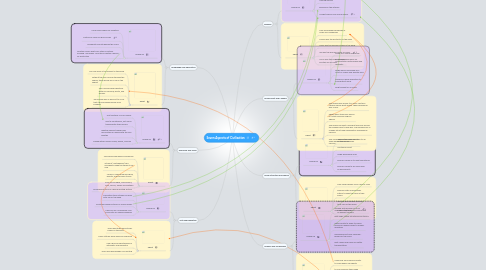
1. Geography and Agriculture
1.1. Huang He
1.1.1. Long rivers helped for irrigation
1.1.2. Fertile soil made for good crops
1.1.3. Temperate climate helped the crops
1.1.4. Isolated Valleys kept from other countries invading. Himalayan Mountains created a barrier for protection
1.2. Egypt
1.2.1. The Nile River is the longest in the world
1.2.2. Without the Nile running through the Sahara, there would be no life in the Sahara
1.2.3. The Nile provided Egyptians water for farming, plants, and animals
1.2.4. The Sahara was so difficult to cross that it discouraged people from invading
2. Economy and Trade
2.1. Huang He
2.1.1. First systems of coin money
2.1.2. Due to isolationism, not much trading with other groups
2.1.3. Wealthy people traded basic necessities for jewels with the less wealthy
2.1.4. Traded within empire crops, jewels, and iron
2.2. Egypt
2.2.1. Sold goods like jewelry and goods
2.2.2. Artisans/ craftspeople/ and merchants made the things to be sold
2.2.3. Mines in Nubia produced gold, granite, and precious stones
2.2.4. Sold ostrich eggs, animal skins, ivory, ebony, slaves and feathers
3. Arts and Education
3.1. Huang He
3.1.1. Developed a style of Chinese writing system
3.1.2. Decorated tomb stones for good after life of the dead
3.1.3. Wrote and drew pictures on oracle bones
3.1.4. Used iron as a "backbone" and in security by making weapons
3.2. Egypt
3.2.1. There paintings were stories based on the gods
3.2.2. There statues were large and imposing
3.2.3. Had a good understanding of arithmetic and geometry
3.2.4. They used hieroglyphics for writing
4. Religion
4.1. Huang He
4.1.1. Rituals had ancestors in mind and were for ancestors.
4.1.2. Ancestors were worshiped and praised
4.1.3. Had big shrines
4.1.4. Believed in the afterlife
4.1.5. Sought advice from oracle bones
4.2. Egypt
4.2.1. They worshipped hundreds of Gods and Goddesses
4.2.2. Anubis was the protector of the dead
4.2.3. Osiris was the king and judge of the dead
4.2.4. Isis was the wife and sister of Osiris
4.2.5. Hurus was the God of the sky and the son of Osiris
5. Social Structure and Family
5.1. Huang He
5.1.1. Many people had free time to do as they please
5.1.2. Hunted for sport
5.1.3. Large disposable army
5.1.4. Farmers called on to fight sometimes
5.1.5. Farmers called to do slave labor on big projects
5.2. Egypt
5.2.1. They varied widely from class to class
5.2.2. Pharohs often married their sisters to keep the royal in their blood
5.2.3. Women and children typically took care of the home
5.2.4. 90% of the population was made of peasant farmers
6. Government and Leaders
6.1. Huang He
6.1.1. Ruled by a strong monarchy
6.1.2. Army was responsible for confrontation both foreign and domestic
6.1.3. Kings were surrounded by a court of nobles and wealthy men
6.1.4. Governors were appointed to ruled distant lands
6.1.5. King thought of as a god
6.2. Egypt
6.2.1. The Pharoh was similar to a King. The term literally means great house. They believed he was a God.
6.2.2. Egypt was a theocracy which is a state ruled by religous figures.
6.2.3. The Pharoh couldn't rule Egypt alone so he had the bureaucracy to help him. The bureaucracy is a highly structured organization managed by officials
6.2.4. The Vizier helped the bureaucracy. They were hundreds of lesser officers.
7. Science and Technology
7.1. Huang He
7.1.1. Worked with bronze for ritual uses and sculptures
7.1.2. Built huge, stable structures and tombs
7.1.3. Melted metal to apply to oracle bones for religious uses to answer questions
7.1.4. Developed first lunar calendar- phases of the moon
7.1.5. Built canals and roads for better transportation
7.2. Egypt
7.2.1. Used pulp from papyrus plants to make paper-like sheets
7.2.2. to cure illnesses they made medicines from plants
7.2.3. Built pyrimads
7.2.4. Used tombs and temples to paint on
